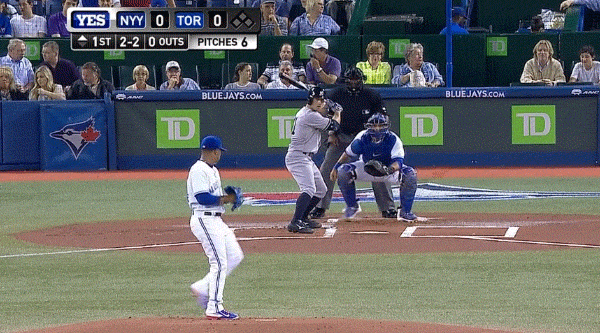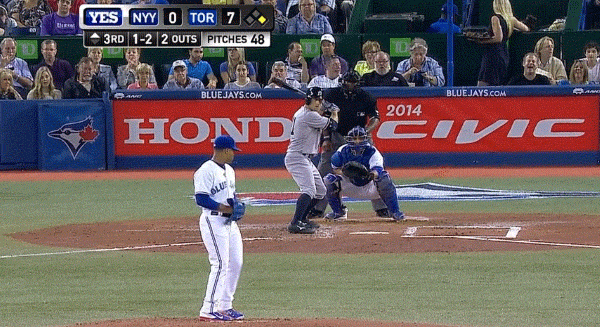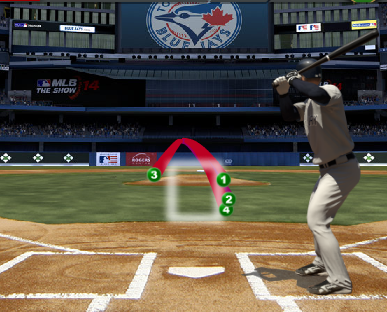What Marcus Stroman learned from the worst start of his career
Marcus Stroman wasn’t supposed to be here, starting games against the New York Yankees. The 2012 first round pick of the Toronto Blue Jays was a reliever in college. He was too short to hack it as a big league starter.
But the Blue Jays saw him as a starter and, after tearing through the minor leagues, Stroman quickly made a name for himself in the big league rotation. He’s opening eyes around the league and helping the first-place Jays maintain their grip on the AL East.
Playing before family and friends at Yankee Stadium, Stroman turned in the worst start of his nascent big league career. The native New Yorker got another shot at the Yankees in his very next start, this time at home in Toronto.
In his first outing (in which he failed to get out of the fourth inning, throwing 98 pitches and allowing two runs and seven base runners), Brett Gardner wore him out, taking Stroman deep with a Yankee Stadium special down the right field line. Gardner is, surprisingly, the Yanks’ best position player this year and a dangerous hitter atop their lineup.
I spoke to Stroman about his gameplan for Gardner, how he attacked him in his great outing Monday night, and what he learned from their previous encounter last week
(Stroman's thoughts/answers italicized)
The Stroman Report - Brett Gardner
He’s a guy that you want to keep off the bases because of his speed. He’s also really hot right now and swinging a good bat. He’s a great hitter in terms of contact, really battling and being pesky. Being that leadoff hitter that’s tough to face.
Last week, I think the first at bat of the game was 12 pitches and that sets the tone for the entire game. It allows all his other hitters to empty the repertoire of the starting pitcher.
The Home Run in New York
Not that bad a pitch, could’ve been a little more down. It was to the bottom half, kind of sweeping into his barrel and hit that lefty sweet spot, right into the path of his swing. He caught it.
The First At Bat - setting the tone
I’m trying to establish my fastball early and once I can get ahead with my fastball, I feel like I have good secondary pitches to put guys away.
A guy like Gardner, he battles. He’ll battle whatever pitch you’re throwing in there, he’ll foul off. He’s almost the guy you want to force him to put the ball in the play and whatever happens, happens.
You don’t want to get too deep into counts with him as then your pitch counts can get driven up.
Just like in New York, Gardner saw a lot of pitches in his first at bat of the game. This time, Stroman stayed with the fastball for seven of the eight pitches. He went for the kill with a slider after Gardner fouled off fastball after fastball.

Missed with it 2-2. It was supposed to be down but it stayed up. Trying to get him to swing over the top of it. Similar to the pitch he hit out but trying keep it down and almost in the dirt.
I was trying to throw him heaters in, that’s what I was trying to do with him.
With the count 3-2, Stroman threw another fastball on the inside half. It was in a good enough spot that Gardner could only fly out to right field for the first out of the game.
The Second At Bat - steady diet of fastballs
You don’t want to be too “nitpicky” with him. He’s a great hitter but he’s not a guy you want to pitch around. If he gets a hit, he gets a hit. You don’t want to waste pitches.
Stroman threw four fastballs in this encounter, getting Gardner looking with a good fastball on the inside part of the plate.

[The strikeout pitch was] just a four-seam fastball. It gets a good amount of run sometimes. It can be straight but it can get a lot of action on it. I don’t really throw any sort of two-seamer/sinkers it’s all four seam.
Stroman does throw a cut fastball, just missing here with the count 0-1.
My cutter is a huge pitch for me, especially against a predominantly lefty-based lineup. It’s a really big pitch to get in on lefties and it looks like the fastball until the last second.
It also helps me if I have trouble getting the fastball in there (to his glove side) in terms of arm slot.
The Jays’ righty demonstrated the aggression he preached earlier, staying with harder pitches even when ahead against the Yankees outfielder.
You don’t want to get where you’re 3-2 or 2-2 because then he’s going to battle-battle-battle. Especially against a guy like him, just trying to stay aggressive and make him put the ball in play.
The Third PA - a walk and a lesson learned
That at bat...I don’t know what I was doing there. [laughs] I might have lost a little focus and just kinda started spinning.

The pitches were all quite close to their spots, but Gardner took some tough pitches and earned his walk. Stroman and his catcher, Dioner Navarro, stuck with the same plan of attack all game long - they tried to pound inside with fastballs.
The game plan, it changes, man. Just stay aggressive and not trying to be too fine. Mostly we just stay with our plan but if he gives me any reason to change, I’ll just adapt in game.
The Takeaway
Obviously Stroman pitched much better in Toronto compared to on the road in the Bronx. His encounters with Brett Gardner demonstrates the importance of aggression and fastball command.
Given Stroman’s stuff, there’s nothing wrong his straightforward approach. A lesson he re-learns every time out.
In New York, I was trying to be too fine with the heater. I was trying to paint it on the outside corner and paint it on the inside corner rather than just going out and being aggressive and working in halves of the plate.
That relentless pursuit of the inside half of the plate helped him retire Gardner twice on Monday night. The run on his inside fastball netted him a strikeout and his ability to throw two similar pitches (with key differences) helped keep his fastball off Gardner’s barrel.
Stroman is promising member of an exciting Blue Jays team. If he keeps learning and stays aggressive, he could be a huge part of them staying in the playoff picture for the first time in two decades.